|
National Archaeological Museum of Athens - Prehistoric Collection
The New York Times has recently (April 2008) published an article on Athens. In it there is a reference to the National Archaeological Museum of Athens: "In neighboring Exarcheia, the renovated National Archaeological Museum (Patission 44; 30-210-821-7724) has classical sculptures and gold treasures from Mycenae". We think of this reference as being the Understatement of the century! |
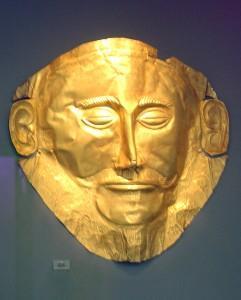 |
Athens National Archaeological Museum:
Exhibit 624. Gold death-mask, known as
the 'mask of Agamemnon'. (Grave V,
Grave Circle A, Mycenae, 16th century BC) |
This is because the Greek National Archaeological Museum in Athens is rightfully considered to be not only the most important, yet also one of the richest archaeological museums in the world in terms of containing Ancient Greek Art! Please refer to the relevant Album as proof of how much right we are!
The Greek National Archaeological Museum is housed in a neoclassical building designed by the noted German architect Ernst Ziller in 1889. It houses perhaps the most impressive collection of ancient Greek treasures in the world. The neoclassical design of the exterior tries its best to keep up with the true Greek classic style of the works it houses. This museum includes the golden so-called "Mask of Agamemnon", excavated by Heinrich Schliemann at ancient Mycenae, the bronze "boy jockey" of Artemision that somehow stayed in great condition despite being fished out of the sea, and a range of excellent sculptures, pottery, furniture and jewellery.
Further wonderful inclusions are:
- Prehistoric items/Ruins
- Sculpture
- Pottery and Minor art
- Bronzes
- Egyptian Art
Operating Hours are as follows:
Monday 13.00-19.30
Tuesday-Sunday 08.30-15.00
Telephone Contact: 210/821-7717 Address: 44, 28th Oktovriou (Patission) Ave, Athens, Greece |
Note: Given the huge number of exhibits, this album on the National Archaeological Museum of Athens is progressing step by step: Please visit this Album from time to time to see it growing!
(Photos: Michael Tziotis)
Select Page of the Album:
- The National Archaeological Museum of Athens: Why this Album?
- The National Archaeological Museum of Athens (The Building)
- Prehistoric Collection / Gallery IV / Mycenaean Civilization / Mycenae
- Gallery IV / Mycenaean Civilization / Mycenae / Grave Circle A / Finds from Graves I, II and VI, 16th century BC
- Gallery IV / Mycenaean Civilization / Mycenae / Grave Circle A / Finds from Grave III, 16th century BC (Window 1)
- Gallery IV / Mycenaean Civilization / Mycenae / Grave Circle A / Finds from Grave III, 16th century BC (Window 2)
- Gallery IV / Mycenaean Civilization / Mycenae / Grave Circle A / Finds from Grave IV, 16th century BC.
- Gallery IV / Mycenaean Civilization / Mycenae / Grave Circle A / Finds from Grave V, 16th century BC.
- Gallery IV / Mycenaean Civilization / Mycenae / Grave Circle A / Jewelry from Graves IV and V, 16th century BC.
- Gallery IV / Mycenaean Civilization / Mycenae / Grave Circle A / Gold and silver tableware from Graves IV and V, 16th century BC.
- Gallery IV / Mycenaean Civilization / Mycenae / Grave Circle A / Pottery vessels, 16th- early 15th century BC.
- Gallery IV / Mycenaean Civilization / Mycenae / Grave Circle A / Ritual vases-rhytons from Graves IV and V, 16th century BC.
- Gallery IV / Mycenaean Civilization / Mycenae / Grave Circle A / Exotic Objects, 16th century BC.
- Gallery IV / Mycenaean Civilization / Mycenae / Grave Circle A / Bronze vessels and tools from Graves III, IV and V, 16th century BC.
- Gallery IV / Mycenaean Civilization / Mycenae / Grave Circle A / Weapons and implements from Grave IV, 16th century BC.
- Gallery IV / Mycenaean Civilization / Mycenae / Grave Circle A / Weapons and implements from Grave V, 16th century BC.
- Gallery IV / Mycenaean Civilization / Mycenae / Grave Circle B / Finds from Graves Alpha, Zeta, Eta and Kappa, 17th-16th cent. BC
- Gallery IV / Mycenaean Civilization / Mycenae / Grave Circle B / Finds from the Male Inhumations in Grave Nu & the Female One in Grave Omicron, 17th-16th cent. BC
- Gallery IV / Mycenaean Civilization / Mycenae / Grave Circle B / Finds from Grave Gamma and Delta, 17th-16th cent. BC
- Gallery IV / Mycenaean Civilization / Mycenae / Grave Circle B / Finds from Graves Beta, Epsilon, Iota, Lamda, Mu, Xi, Upsilon, 16th century BC.
- Gallery IV / Mycenaean Civilization / Mycenae / Bone, Glass and Ivory Artifacts from the Mycenean Acropolis
- Gallery IV / Mycenaean Civilization / Mycenae / Palatial Workshops Finds and Bronze Weapon and Tool Hoards in the Acropolis of Mycenae, 14th-13th centuries BC
- Gallery IV / Mycenaean Civilization / Mycenae / Imported objects and raw materials from abroad, most found on the Mycenae acropolis.
- Gallery IV / Mycenaean Civilization / Mycenae / Clay and stone ritual vessels, used in religious ceremonies (15th-12th century BC).
- Gallery IV / Mycenaean Civilization / Mycenae / Pictorial Style pottery from the Mycenae acropolis.
- Gallery IV / Mycenaean Civilization / Mycenae / Wall-Paintings
- Gallery IV / Mycenaean Civilization / Tiryns/The Tiryns wall-paintings
- Gallery IV / Mycenaean Civilization / Tiryns/The Acropolis of Tiryns
Click on any of the pictures to enlarge.
Gallery IV / Mycenaean Civilization / Tiryns/The Tiryns wall-paintingsAt Tiryns, as in the rest of the Mycenaean world, painters worked for the king (14th-13th centuries BC). Large-scale wall-paintings usually represent religious ceremonies and hunting scenes. The former include processions and ritual bull-leaping, where the influence of Minoan Crete is evident Wild-boar, whose tusks were used to make helmets, were a favorite pray for the Mycenaean ruling class, who used chariots for both hunting and battle. The participation of women in religious processions and hunts denotes their elevated status in the Mycenaean world.
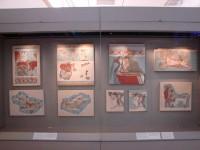
National Archaeological Museum: General View of the Tiryns Wall-paintings Window |
|
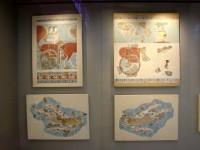
National Archaeological Museum: Half of the Window in the previous photo to the left. |
|
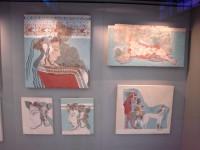
National Archaeological Museum: Half of the Window in the previous photo to the right. |
|
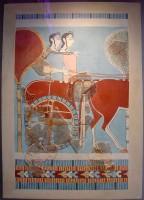
5878-5882. Wall-painting fragments with a representation of a wild-boar hunt.
Women in a chariot watch the hounds attack a wounded pray in the forest. A footman follows, leading more hounds. From the later Tiryns palace. |
|
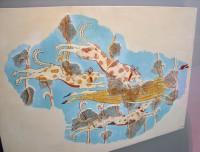
5878-5882. Wall-painting fragments with a representation of a wild-boar hunt.
The hounds attacking the wounded pray in the forest. From the later Tiryns palace. |
|
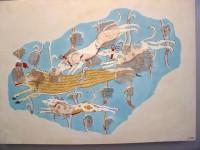
5878-5882. Wall-painting fragments with a representation of a wild-boar hunt.
The hounds attacking the wounded pray in the forest. From the later Tiryns palace. |
|
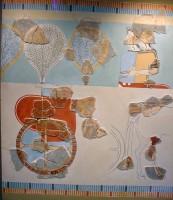
5878-5882. Wall-painting fragments with a representation of a wild-boar hunt. |
|
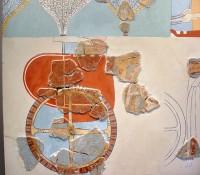
5878-5882. Wall-painting fragments with a representation of a wild-boar hunt. (Chariot detail) |
|
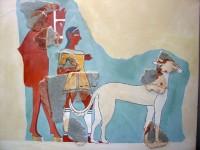
5878-5882. Wall-painting fragments with a representation of a wild-boar hunt. (Chariot detail)
A footman follows, leading more hounds. From the later Tiryns palace. |
|
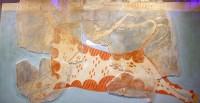
1595. Wall-painting fragments with a representation of bull-leaping (Taurokathapsia).
An acrobat leaps over the bull while holding onto its horns. This ritual theme symbolizes the struggle and dominion of man over wild nature. From the earlier Tiryns palace. |
|
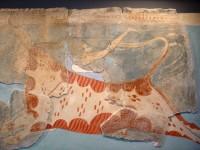
1595. Wall-painting fragments with a representation of bull-leaping (Taurokathapsia). (Detail)
An acrobat leaps over the bull while holding onto its horns. This ritual theme symbolizes the struggle and dominion of man over wild nature. From the earlier Tiryns palace. |
|
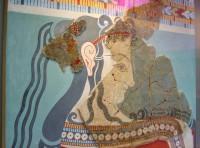
5883. Wall-painting fragments with a representation of a procession of women bearing offerings for a deity.
Their facial characteristics, elaborate hairstyle and rich garments are visible on the best preserved figure. Bands of rosettes and stylized ivy-leaves frame the composition. From the later Tiryns palace. |
|
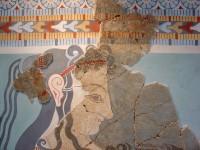
5883. Wall-painting fragments with a representation of a procession of women bearing offerings for a deity (Same theme as in the previous photo).
Their facial characteristics, elaborate hairstyle and rich garments are visible on the best preserved figure. Bands of rosettes and stylized ivy-leaves frame the composition. From the later Tiryns palace. |
|
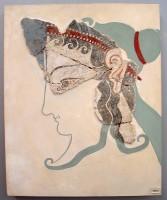
5883. Wall-painting fragments with a representation of a procession of women bearing offerings for a deity.
From the later Tiryns palace. |
|
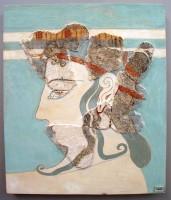
5883. Wall-painting fragments with a representation of a procession of women bearing offerings for a deity.
From the later Tiryns palace. |
|
|
Select Page of the Album:
- The National Archaeological Museum of Athens: Why this Album?
- The National Archaeological Museum of Athens (The Building)
- Prehistoric Collection / Gallery IV / Mycenaean Civilization / Mycenae
- Gallery IV / Mycenaean Civilization / Mycenae / Grave Circle A / Finds from Graves I, II and VI, 16th century BC
- Gallery IV / Mycenaean Civilization / Mycenae / Grave Circle A / Finds from Grave III, 16th century BC (Window 1)
- Gallery IV / Mycenaean Civilization / Mycenae / Grave Circle A / Finds from Grave III, 16th century BC (Window 2)
- Gallery IV / Mycenaean Civilization / Mycenae / Grave Circle A / Finds from Grave IV, 16th century BC.
- Gallery IV / Mycenaean Civilization / Mycenae / Grave Circle A / Finds from Grave V, 16th century BC.
- Gallery IV / Mycenaean Civilization / Mycenae / Grave Circle A / Jewelry from Graves IV and V, 16th century BC.
- Gallery IV / Mycenaean Civilization / Mycenae / Grave Circle A / Gold and silver tableware from Graves IV and V, 16th century BC.
- Gallery IV / Mycenaean Civilization / Mycenae / Grave Circle A / Pottery vessels, 16th- early 15th century BC.
- Gallery IV / Mycenaean Civilization / Mycenae / Grave Circle A / Ritual vases-rhytons from Graves IV and V, 16th century BC.
- Gallery IV / Mycenaean Civilization / Mycenae / Grave Circle A / Exotic Objects, 16th century BC.
- Gallery IV / Mycenaean Civilization / Mycenae / Grave Circle A / Bronze vessels and tools from Graves III, IV and V, 16th century BC.
- Gallery IV / Mycenaean Civilization / Mycenae / Grave Circle A / Weapons and implements from Grave IV, 16th century BC.
- Gallery IV / Mycenaean Civilization / Mycenae / Grave Circle A / Weapons and implements from Grave V, 16th century BC.
- Gallery IV / Mycenaean Civilization / Mycenae / Grave Circle B / Finds from Graves Alpha, Zeta, Eta and Kappa, 17th-16th cent. BC
- Gallery IV / Mycenaean Civilization / Mycenae / Grave Circle B / Finds from the Male Inhumations in Grave Nu & the Female One in Grave Omicron, 17th-16th cent. BC
- Gallery IV / Mycenaean Civilization / Mycenae / Grave Circle B / Finds from Grave Gamma and Delta, 17th-16th cent. BC
- Gallery IV / Mycenaean Civilization / Mycenae / Grave Circle B / Finds from Graves Beta, Epsilon, Iota, Lamda, Mu, Xi, Upsilon, 16th century BC.
- Gallery IV / Mycenaean Civilization / Mycenae / Bone, Glass and Ivory Artifacts from the Mycenean Acropolis
- Gallery IV / Mycenaean Civilization / Mycenae / Palatial Workshops Finds and Bronze Weapon and Tool Hoards in the Acropolis of Mycenae, 14th-13th centuries BC
- Gallery IV / Mycenaean Civilization / Mycenae / Imported objects and raw materials from abroad, most found on the Mycenae acropolis.
- Gallery IV / Mycenaean Civilization / Mycenae / Clay and stone ritual vessels, used in religious ceremonies (15th-12th century BC).
- Gallery IV / Mycenaean Civilization / Mycenae / Pictorial Style pottery from the Mycenae acropolis.
- Gallery IV / Mycenaean Civilization / Mycenae / Wall-Paintings
- Gallery IV / Mycenaean Civilization / Tiryns/The Tiryns wall-paintings
- Gallery IV / Mycenaean Civilization / Tiryns/The Acropolis of Tiryns
|
|
|
|



